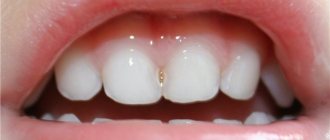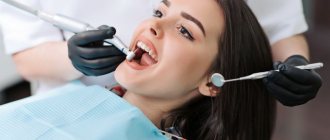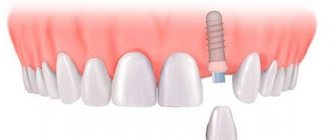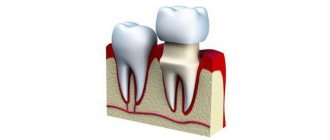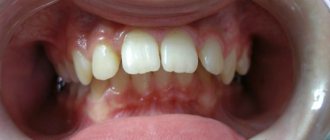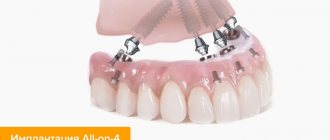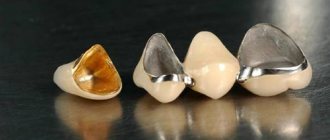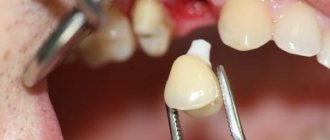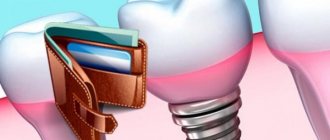Features of treatment of anterior teeth
The four incisors in the center of the upper and lower jaws are the front teeth. They are capricious, with a thin layer of enamel and dentin, caries strikes them quickly. Therefore, at the slightest discomfort, run to the dentist!
The front teeth are a very important area not only for the patient, but also for the dentist. They are always visible; everyone will notice errors in treatment. Incisors require jewelry precision from the dentist; the enamel is thinner, so the patient experiences more pain. Don’t forget about aesthetics - an incorrectly chosen filling color or poor degree of transparency will ruin the entire treatment.
The smile area requires special care. Observation should be made for crowded front teeth that overlap each other and are too large. The lack of vitamins in the body primarily affects the incisors - vitamin deficiency does not cost anything to undermine the already thin enamel. Food that often gets stuck in the interdental spaces warns of impending caries. It is better not to delay your visit to the clinic where front teeth are treated in Moscow: at the very beginning, caries is treated without the use of a drill.
When is a visit to the dentist necessary?
In some cases, it is possible to overcome toothache and inflammation with home remedies, but sometimes you should run to the dentist as soon as possible, for example, if:
- symptoms of inflammation (swelling, redness, bleeding) increase;
- the pain does not go away despite painkillers. It intensifies and spreads to neighboring areas of the oral cavity;
- body temperature rises;
- there are problems with opening and closing the mouth;
- there was a traumatic effect on the facial area.
These symptoms, especially their combination, may indicate the development of life-threatening conditions. In such cases, the clock is ticking, and failure to provide timely assistance can lead to death. In particularly difficult situations, you should call an ambulance. Hospitalization and emergency medical measures will help maintain a person’s health and save a life.
This is interesting: Cofferdam - what is it and why is it used in dental treatment
Dental problems require attention and treatment. The proximity of vital organs increases the risks of possible complications. In order not to tempt fate, it is better to treat your teeth in a timely and complete manner.
Treatment methods – from filling to implant
The dentist will select the treatment method for the front teeth after an examination.
- Veneers or Lumineers
If the incisors are severely damaged, thin overlays can be placed - veneers or lumineers. They will hide the consequences of caries and make teeth whiter and smoother.
- Dental crowns
If only the root remains of the front tooth, intra-root inlays are made; this is the basis for the crown. Metal crowns are not suitable for front teeth; they will be too noticeable. To make an artificial tooth as similar as possible to a real one, it is better to use ceramic and zirconium crowns.
- Bridges and implants
If desired, missing front teeth can be replaced by bridges and clasp dentures. If funds allow, you can install an implant and forget about the problem for many years.
Treatment of caries of anterior teeth
The main method of treating caries in the front teeth is filling. When it comes to incisors, in the language of dentists this is called very beautifully - artistic restoration. It is better not to save on the cost of the filling. High-quality material will last longer and will not spoil your smile. The front teeth are always visible, so the dentist has to select the color and degree of transparency of the filling with pinpoint precision; it must match the shade of the tooth as closely as possible. Reflective composite materials do not spoil the aesthetic appearance. Over time, light fillings do not darken or wear off.
Crack on front tooth
The front teeth always get the most damage. When they “punch you in the teeth,” the blow usually falls on them. They fell unsuccessfully, worried, chewed a pencil, or, horror of horrors, chopped nuts with their incisors, and now a crack appeared on the front tooth. By the way, it can occur without mechanical damage - for example, due to temperature changes. Teeth don't really like iced coffee. You shouldn’t overuse citrus fruits or their juices either, and it’s best to dilute freshly squeezed juices with water to reduce their acidity. You should not get carried away with whitening procedures, and be more careful with abrasive pastes. Cracks are also different.
Vertical
If you are “lucky” and it is small vertical, then nothing bad will happen to this tooth, and the defect will be barely noticeable. In this case, many dentists do not recommend loading the tooth with patches. But you still need to keep an eye on the crack. If it increases, the enamel changes color, and the tooth reacts sharply to hot/cold, sweet/salty, you should consult a dentist. The enamel will need to be restored and strengthened. The crack will be treated with a special compound containing calcium and fluorine. After the course of treatment, the tooth will react normally to food and become more even and smooth.
Horizontal
But horizontal or oblique cracks in the front teeth are a cause for serious concern. They provoke the formation of caries, chips and can generally lead to tooth loss. Treatment depends on the size, depth and location of the crack, as well as the characteristics of the enamel. If there are many microcracks on the tooth and the color of the enamel has changed, the doctor may suggest installing veneers, but only after treating caries and other oral diseases. A crack left unattended will permanently split the tooth. Then there will only be one treatment option left - prosthetics.
Causes of discomfort
If one tooth aches
If only one tooth aches, then we are talking about limited or localized hyperesthesia. Why is this happening? The most common reasons:
- Development of caries. Dentin has a fairly loose structure, so it allows irritants to pass to the nerve, which causes attacks of pain.
- Inflammation of the gums. Gingivitis can be caused by mechanical damage to soft tissue, infection, or even allergies.
- Damage to enamel. The causes of toothache lie in the thinning of hard tissues due to incorrect whitening performed by a doctor or due to the patient’s constant use of toothpastes with abrasive particles. Microcracks appear due to improper bite, unbalanced diet and lack of vitamins. There is no visible hole, but the person feels severe discomfort.
- A crown was installed. Pain under the prosthesis indicates poor quality work by the doctor. Most likely, he did not completely fill the canal or damaged its wall when installing the pin, which is why the dental unit begins to ache and ache. The problem can only be solved by re-sanitation of the oral cavity and installation of a new prosthesis.
- A seal was installed. If a patient’s filled tooth hurts, the cause of the discomfort is that the dentist removed the nerve (for more details, see the article: what to do if the filled tooth hurts?). As a rule, the pain goes away after a few days. However, pain inside the tooth with a long-standing filling indicates secondary caries.
The symptom may indicate the following conditions:
- cyst on the root, inflammation of the gums, caries, which may cause fever and swelling of the face;
- migraine, otitis media, trigeminal neuralgia;
- diseases of the pancreas, leg joints and other organs.
Based on the nature of toothache, specialists are able to suspect problems in the functioning of the internal systems of the body, since each organ is “tied” to a specific dental unit. For example, if the lower front teeth hurt, the reason may lie in impaired kidney function; disturbing fangs indicate liver dysfunction; 6th and 7th molars indicate improper functioning of the stomach.
There is also the concept of phantom toothache - in this case, a person is worried about discomfort not only in healthy teeth, but even in places where they have been removed. This happens because diseased internal organs reflexively transmit signals to the area of units that correspond to them.
Why can all teeth hurt and ache?
Aching pain affecting the entire jaw can indicate a huge number of different diseases. Patients often notice the following signs:
- discomfort is felt only at night;
- teeth hurt on one side;
- toothache makes itself felt after drinking alcohol;
- unpleasant sensations occur on the right and left, in the upper or lower jaw;
- When closing, the fangs or incisors hurt.
Why do all my teeth hurt at once? There may be several reasons:
- Pain that occurs on all units at the same time may indicate periodontal disease or periodontitis. If the disease is not treated, you may lose your teeth in the near future.
- Similar symptoms may appear after the extraction of a tooth. During the normal regeneration process, the discomfort goes away on its own.
- The symptom may indicate enamel hypersensitivity. This reaction appears periodically and quickly disappears.
- With pulpitis, discomfort sometimes occurs, affecting all the teeth above or below at once. At the same time, the pain is not constant - it appears and goes away.
- Aching pain can occur when wisdom teeth erupt incorrectly.
- When the gum area at the very neck becomes inflamed, painful sensations are transmitted to the entire mucous membrane.
- The feeling that all your teeth hurt occurs when you have a root cyst. The discomfort does not have a clear localization; with an exacerbation of the disease, an increase in temperature is possible.
- With angina pectoris, discomfort is felt in the jaw on the left side. This sign may be a harbinger of a heart attack.
- Otitis media provokes pain from the posterior molars. Since the disease can lead to meningitis, it requires urgent treatment.
- Aching teeth on the right or left side indicate inflammation of the trigeminal nerve.
- With sinusitis, discomfort is sometimes felt on one or both sides of the upper jaw.
Loose front teeth
Loose front teeth are a wake-up call. Often this trouble happens with the front teeth. The main cause of looseness is gum disease: periodontal disease, stomatitis, gingivitis. You should not run them, otherwise you may end up without teeth at all.
The doctor will select the treatment for loose teeth individually. If the swaying is accompanied by pain, the teeth deviate significantly to the sides, the dentist applies special splints, removable or non-removable, to the incisors. Splinting strengthens mobile teeth, prevents their loss, and allows periodontal tissues to recover. In severe cases, surgical treatment cannot be avoided. During surgery, the surgeon removes bone tissue or restores it using metal shunts.
Cysts in the tooth canal and granuloma have a bad effect on the roots, and the teeth begin to become loose. These tumors need to be removed. If the tooth begins to loosen after a blow or injury, it is better to go for an x-ray.
Anesthesia
Anesthesia allows you to avoid pain during dental treatment. Dentists recommend doing it in any case if there is a need to work with a drill. This is not caused by a desire to increase the cost of treatment, but by the fact that it is not always possible to determine the depth of the cavity in advance by its appearance.
Anesthetic agents are very diverse and allow you to choose a drug that will be the most effective and safe for each individual patient.
Does it hurt to get an injection in the gum?
An injection into the gum is needed to inject an anesthetic into the tissue near the nerve. As a rule, several such injections are required to obtain the effect. There are several different methods of distributing injections, and the doctor chooses the right one based on the condition of the teeth of a particular patient. The injection itself is painful, since the gum mucosa is quite sensitive.
Drill
With proper anesthesia, drilling a tooth does not hurt – this is precisely the purpose for which it is done.
The dentist's manipulations are felt as pressure, discomfort, and movement of the tooth in the gum. This is normal, although unpleasant. In some cases, the doctor decides that additional anesthesia is not required to avoid allergic reactions.
If pain occurs during tooth drilling under anesthesia, inform your doctor.
Pain during the anesthesia process
The classic method of anesthesia is the injection of the active substance into the gums. The injection is painful, especially since you need to do several of them. Pain is reduced by using special syringes with a very thin needle.
If your front tooth hurts after treatment
Patients often complain that their front teeth hurt after treatment. The dentist cleaned the canals, so this is normal. The discomfort should go away within a few hours. But if the treatment is done poorly, the tooth may hurt for a long time - and this is already a deviation from the norm. Most likely, the doctor made a mistake during treatment and the entire filling process will have to be repeated. The cause of pain can be a burn of the pulp, damage to the enamel, an allergy to medications, or acid contact with dentin.
Diagnostics
To identify the cause of toothache and develop a treatment plan, the dentist conducts diagnostics. First, the doctor listens to complaints, finds out when the pain appears, and how severe it is.
Then the oral cavity is examined.
To determine the cause of pain, the doctor uses a number of techniques:
- tapping with a probe, exposure to cold water to identify the localization of pain;
- palpating the gums for swelling;
- X-ray to view structural damage, bypassing tissue and skin.
To maintain a healthy dentition, you should undergo a preventive examination every six months or visit the dentist if discomfort occurs in the oral cavity.
How much does front tooth treatment cost?
The cost of treatment depends on the method and materials used. When it comes to the smile area, it is better not to skimp. In this case, prudent patients often have to remember the stingy man who pays twice. Choosing cheap materials often leads to aesthetic flaws, disappointment and repeated treatments.
As a rule, prices for treatment of front teeth in Moscow start from 2,000 rubles. For example, the cost of caries treatment without drilling ranges from 2,000 to 5,500 rubles. A light seal costs from 1,500 to 10,000 rubles. The price tag for splinting loose front teeth starts from 2,800 to 7,000 rubles. Removing a cyst will cost 7,000 - 37,000 rubles, granulomas - from 5,000 to 40,000. A dental inlay will cost from 5,200 to 20,000 rubles. Prices for veneers start from 5,000 rubles, lumineers - from 40,000. The range of prices for zirconium crowns is from 13,500 to 40,000, ceramic - from 17,000 to 57,000. Clasp prosthesis will cost from 29,000 to 73,000, dental implantation - from 30,000 to 120,000 and more.


